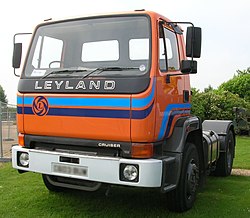Leyland Cruiser
| Leyland | |
|---|---|
|
Leyland Cruiser 1985
|
|
| Cruiser | |
| Manufacturer: | Leyland Trucks |
| Sales designation: | Leyland Cruiser |
| Production period: | 1982-1990 |
| Previous model: | Leyland Buffalo |
| Successor: | Leyland DAF 70/80 |
| Technical specifications | |
| Engines: | Leyland TL11 / TL11C inline six cylinder diesel engine |
| Power: | 155-191 kW |
| Perm. Total weight: | Max. 28 t |
The front-handlebar truck Leyland Cruiser is a tractor unit and a tipper vehicle from the British Leyland Motor Corporation located below the Leyland Roadtrain . The driver's cab of the 1982 series was based on the T45 Project . Due to the British road transport GVW regulations still in force at the time, the gross vehicle weight, in contrast to the Roadtrain, was only up to 28 tons and it was only available with rear-axle drive ( drive formula 4 × 2). The cruiser replaced the Leyland Buffalo , which had been built in the 1960s, in the market segment. After the merger of Leyland Motors and DAF to Leyland DAF and the simultaneous relaxation of the GVW regulations, production of the Leyland Cruiser was discontinued in 1990. The Leyland Roadtrain took its place in the model range and was now offered as the Leyland DAF 70/80 in Great Britain and as the DAF 70-80 in continental Europe .
Model history
The Leyland Buffalo had the Leyland / AEC - "Ergomatic Cab" driver's house, which first came onto the market in the 1960s. The design was therefore completely out of date. The Buffalo, too, originally had the new, but initially unreliable, direct injection diesel engine Leyland 500 OHC . After BLMC had revised this engine to the Leyland 0-680 and used it as the L11 and TL11 in the Buffalo, the technical reliability was given. Therefore, the TL11 6-cylinder diesel engine was also adopted for the cruiser, with an output of 210 or 230 hp. The power was mostly transmitted by a Fuller R10 manual gearbox, but Spicer gearboxes were also available on request.
The chassis of the cruiser came largely from the predecessor Buffalo. At the rear it had a hub reduction rear axle that Albion supplied. In contrast to the Leyland Roadtrain, there were no alternative engine offers from other manufacturers, and the driver's cab was smaller than that of the Roadtrain. The cruiser had a T45 cabin in a normal version or as a double cabin with sleeping facilities and was not available with a high roof, parallel to the Leyland Freighter .
In 1985, the Cruiser, like the rest of the models, was slightly redesigned, the most striking feature being the introduction of the Leyland TL11C diesel engine with 260 hp. After the merger of Leyland DAF and the changed British transport company GVW regulations, the production of the cruiser was stopped in 1990. The successor was the Leyland Roadtrain, which was renamed and modernized at the same time as Leyland DAF 70/80 or DAF 70/80.
